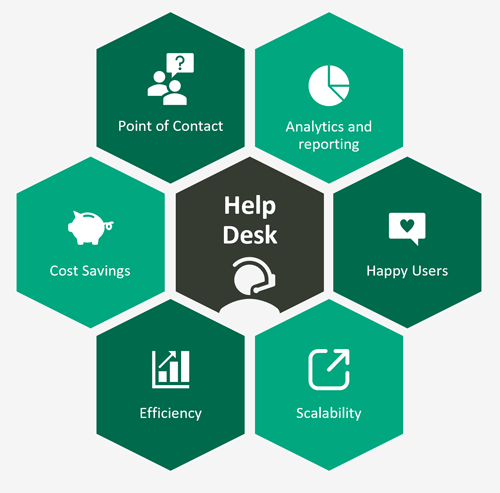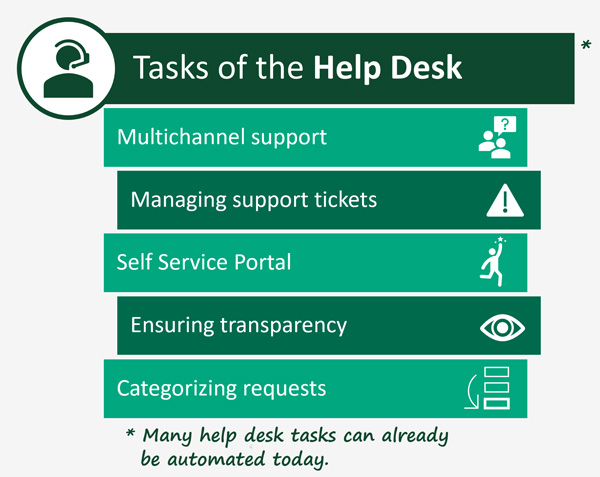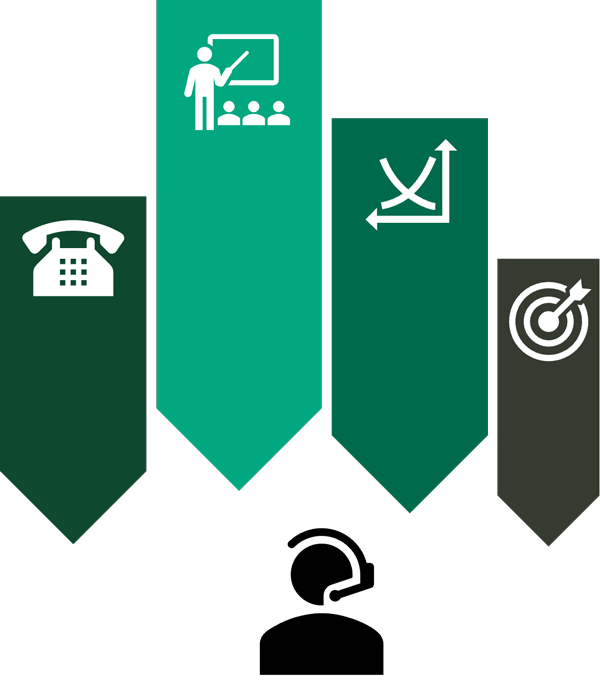Questions and answers about Help Desk Software
When it comes to the topic of Help Desk Software, many questions arise among users and companies alike. What are the advantages of such software, who can and should use it, and what does such software actually do? It is precisely those questions that we address and answer in the following sections.
What is Help Desk Management Software?
The basic functions of Help Desk Software (also popularly referred to as an IT Ticketing System) are to help service teams systematically manage support requests, provide self-service options, and track and evaluate performance.
Self-service options are a critical tool for improving Help Desk acceptance. The service catalog plays a central role in this. The evaluation and use of the services depends to a large extent on the design of this catalog.
When used by IT teams, the goals and processes of a Help Desk are based on best practices, such as those in ITIL (Information Technology Infrastructure Library).
In practical terms, the IT Help Desk System provides a toolset that enables organizations to respond to customer inquiries and incidents in a targeted manner. To do this, customers contact the company with questions and problems via email, phone, web, chat bots and social media.
The system generates a ticket for each problem and automatically links it to the customer history, if applicable. The same applies to internal requests, i.e. when employees face problems in the course of their daily work.
The tickets are assigned manually or automatically. While support agents are working on tickets, they can easily collaborate with other team members to get assistance. Once the support staff has solved the problem, they inform the user.
Administrators can define precise workflows and assign different levels of responsibility to support staff. With analytics, you can track metrics on common incidents, internal KPIs, and more. However, not all Help Desk Solutions are the same.
Many Help Desk Solutions, such as those from REALTECH (also called “Service Desk”), focus on internal IT teams. In the case, the system is used by IT support staff, experts and managers to provide support to internal employees. In the following, we will also focus on this form of software solution.
Why Help Desk Software pays off
Forms of communication are increasingly evolving, often changing at breakneck speed, and so no one knows exactly which channel your end users will prefer tomorrow. By using Help Desk Software, your employees can access support options whenever they need help, completely independent of their preferred platforms.
In addition, good Help Desk Software offers the following benefits to your business:
Overall, a help desk tool can increase the efficiency and effectiveness of your IT department, make your employees happier and more efficient and give your company a competitive advantage. Therefore, investing in high-quality help desk software is beneficial for every company.
A good IT Help Desk System, such as the one from REALTECH, can do just that and provide concrete support for the following tasks:
So if you are prepared to invest in high-quality software, this will have a positive impact on your company in the long term. But who exactly uses an IT Help Desk System within a company?
Who uses IT Help Desk Software?
A help desk system is used by various departments in the company, including IT teams, customer service representatives, customer success teams, technicians and other support and service employees.
The internal IT department is often the main user of IT help desk software. IT staff use the software to track incoming support tickets, diagnose and resolve problems, prioritize user requests and comply with service level agreements. They track tickets, manage resources and coordinate services and support teams.
Technicians use help desk software to log service requests, manage work orders and update the status of support requests.
Companies that offer customer support often use helpdesk software to manage customer support requests. This may include technical support for products or services, but also general inquiries or complaints.
What is the difference between Service Desk and Help Desk Software tools?
A Service Desk and a Help Desk are both IT support solutions that help to resolve problems and assist users with IT issues, but are often lumped together. However, the main difference between the two lies in their scope and functionality.
An IT help desk system is usually limited to supporting end users and solving problems that are directly related to the IT infrastructure. It is therefore usually the first point of contact for IT support and is responsible for receiving, classifying, prioritizing and resolving incidents.
A Service Desk, on the other hand, is a comprehensive solution that encompasses a broader range of functions and tasks. A Service Desk not only supports end users, but also other IT areas such as Incident Management, Change Management, Problem Management, and Service Level Management. Here you will find a compact summary of the main differences:
- The Service Desk is a further development of the Help Desk based on the ITIL framework and the concept of managing IT as a service.
- The Help Desk has developed from the IT orientation (mainframe computing), while the Service Desk has developed from the IT service orientation (based on the ITIL-supported approach to providing IT as a service).
- Depending on the company, you can also say that a Help Desk is more tactically oriented, while a Service Desk is more strategically oriented.
- With a Service Desk, the focus is on providing users with services (requests of all kinds) that go in the direction of customer service. A Help Desk, on the other hand, is designed for problem resolution alone (Incident Management).
- Unlike the Help Desk, the Service Desk is part of an IT service delivery system (an IT support ecosystem) based on the so-called service lifecycle. This is also the key reason for using the term Service Desk instead of Help Desk in the ITIL framework.
Good to know: Other synonyms for Help Desk include: Help Desk Management Software, IT Service Help Desk Software, IT Help Desk System or Help Desk Tracking System.
What functions can and should an IT Help Desk System have?
An effective Help Desk System is a must for any business, especially IT departments and customer support. It is a tool for quickly resolving technical issues and problems and for organizing and automating the workflow in a company. In this section, we will take a look at the key features of an effective IT Help Desk System.
What are the different types of Help Desk Tools?
There are several types of Help Desk Software solutions on the market. The difference between them is mostly …
- … in the nature of their hosting options,
- … in the application inside or outside the company,
- … in whether they were developed specifically for certain companies and
- …in the type of software code used – whether there is openly available code or proprietary code.
Choosing the right Help Desk Software depends on a number of factors, including company size, complexity and expertise within the IT department, and specific support requirements.
At REALTECH, for example, you have the advantage of being able to purchase individual modules separately or together, such as Incident Management, Problem Management, Knowledge Management, or Change Management.
We offer a complete ITSM Solution that is characterized in particular by high flexibility and integration into known system landscapes. Depending on which requirements are paramount and which modules offer your company the most added value. We also offer integration into SAP and MS Teams.
What challenges does Help Desk Software bring?
Ensuring that users accept the help desk and use it consistently is one of the biggest challenges when using this software. After all, a platform alone cannot solve your support problems; your employees must also (be able to) use this tool and not seek a detour via the telephone or a personal conversation with IT support.
REALTECH’s Help Desk Software specializes in IT support. This makes it the starting point for the company’s employees to report incidents, obtain solutions or make use of services.
In addition, the help desk can be extended to the external customer side, provided that the application scenarios can be mapped. As a cloud solution, it is technically no problem to make the Help Desk (as well as the Service Desk) accessible to external customers in order to post tickets or requests.
For this, it is crucial that you have a strategy in place when implementing a Help Desk System and that you train your staff to ensure that support is optimized as planned. Otherwise you overload your workflow with only one tool without being able to draw any optimization from it.
Another challenge when using help desk software is the question of how to make use of the generated data. Because even if an IT help desk system has powerful reporting and analysis functions, the responsible teams must also make the best possible use of the data and thus optimize processes in a targeted manner.
4 tips for providing a helpful Help Desk
Want to know how to make your Help Desk efficient? Because even if you have great Help Desk Software, it won’t do you any good if your Help Desk doesn’t take the following 4 tips to heart.




